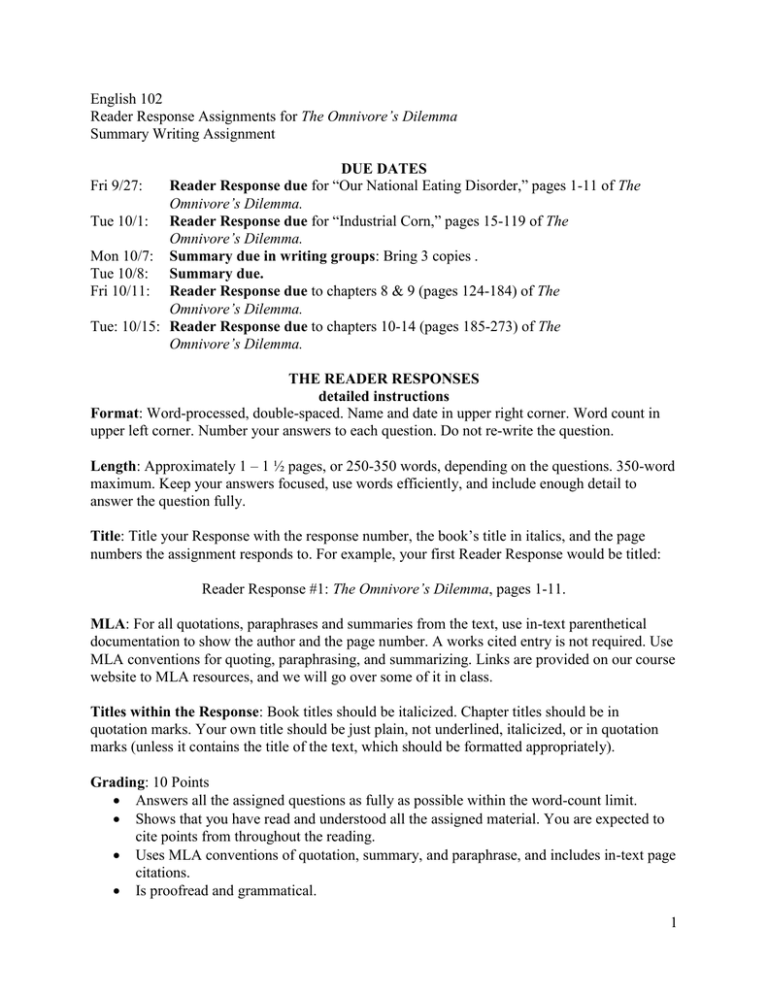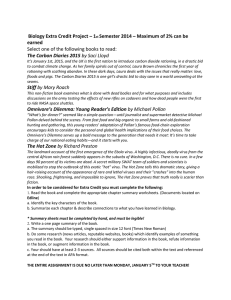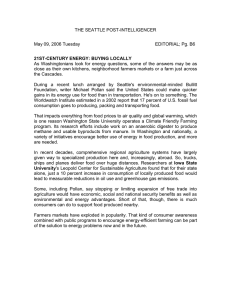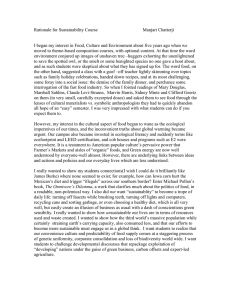English 102 The Omnivore’s Dilemma Summary Writing Assignment
advertisement

English 102 Reader Response Assignments for The Omnivore’s Dilemma Summary Writing Assignment DUE DATES Fri 9/27: Reader Response due for “Our National Eating Disorder,” pages 1-11 of The Omnivore’s Dilemma. Tue 10/1: Reader Response due for “Industrial Corn,” pages 15-119 of The Omnivore’s Dilemma. Mon 10/7: Summary due in writing groups: Bring 3 copies . Tue 10/8: Summary due. Fri 10/11: Reader Response due to chapters 8 & 9 (pages 124-184) of The Omnivore’s Dilemma. Tue: 10/15: Reader Response due to chapters 10-14 (pages 185-273) of The Omnivore’s Dilemma. THE READER RESPONSES detailed instructions Format: Word-processed, double-spaced. Name and date in upper right corner. Word count in upper left corner. Number your answers to each question. Do not re-write the question. Length: Approximately 1 – 1 ½ pages, or 250-350 words, depending on the questions. 350-word maximum. Keep your answers focused, use words efficiently, and include enough detail to answer the question fully. Title: Title your Response with the response number, the book’s title in italics, and the page numbers the assignment responds to. For example, your first Reader Response would be titled: Reader Response #1: The Omnivore’s Dilemma, pages 1-11. MLA: For all quotations, paraphrases and summaries from the text, use in-text parenthetical documentation to show the author and the page number. A works cited entry is not required. Use MLA conventions for quoting, paraphrasing, and summarizing. Links are provided on our course website to MLA resources, and we will go over some of it in class. Titles within the Response: Book titles should be italicized. Chapter titles should be in quotation marks. Your own title should be just plain, not underlined, italicized, or in quotation marks (unless it contains the title of the text, which should be formatted appropriately). Grading: 10 Points Answers all the assigned questions as fully as possible within the word-count limit. Shows that you have read and understood all the assigned material. You are expected to cite points from throughout the reading. Uses MLA conventions of quotation, summary, and paraphrase, and includes in-text page citations. Is proofread and grammatical. 1 Specific Reader Response Assignments Reader Response #1: Due Fri 9/27 Reading: “Our National Eating Disorder,” pages 1-11 of The Omnivore’s Dilemma. 1. What is “the omnivore’s dilemma”? Define what it is and say why, according to Pollan, it’s a problem for a modern eater. 2. Compose a discussion question about the reading to bring to class. A good discussion question 1) does not require a factual answer and is not a yes/no question, 2) invites many different points of view in response, and 3) asks readers to connect material from all throughout the assigned text. 3. To paraphrase means to put another writer’s text into your own words. A good paraphrase retains the precise ideas of the original and uses different vocabulary and sentence structure. Since paraphrases are not quotations, they do not use quotation marks. Paraphrase the following sentence, and be sure to include the page citation at the end, punctuated correctly. “Our culture codifies the rules of wise eating in an elaborate structure of taboos, rituals, recipes, manners, and culinary traditions that keep us from having to reenact the omnivore’s dilemma at every meal” (Pollan 4). 4. Paraphrase the following sentence: “To go from the chicken (Gallus gallus) to the Chicken McNugget is to leave this world in a journey of forgetting that could hardly be more costly, not only in terms of the animal’s pain but in our pleasure, too” (Pollan 10). Reader Response # 2: Due Tue 10/1 Reading: “Industrial Corn,” pages 15-119 of The Omnivore’s Dilemma. 1. In your own words, write a sentence conveying the overall main idea of this selection. Make sure you have a complete sentence, and that your statement includes a topic and an idea about that topic. For example, a topic could be “corn in America”; the idea would state exactly what the selection has to say about corn in America. To get started, you can use this sentence template: In this selection about __(topic)____, the writer says that ___(idea)____. 2. a, b, and c: What are the three most important sub-points in the reading? Write a sentence or two about each one. Use mostly your own words; however, you can include brief quotations from Pollan within your sentences. Make sure to cite page numbers for all summary, paraphrase, and quotation. Each one of your three important sub-points will include page citations. 3. What’s your new favorite vocabulary word from this selection? Use the word in a sentence of your own that clearly defines its meaning. Be sure that the sentence provides context that defines the word. Observe that “The amount was dwindling” does not clearly define the word “dwindling.” However this sentence does: “The amount of fresh water in the stream dwindled 2 almost to nothing, so the horses had to go elsewhere to drink.” Do not paste a dictionary definition into this assignment. 4. Paraphrase the following passage. However, write it in the third person (Pollan, he) and not as an “I,” as Pollan does. You can begin with a phrase like “Pollan thinks that…” or “Pollan speculates that…” Perhaps the reason you eat this food quickly is because it doesn’t bear savoring. The more you concentrate on how it tastes, the less like anything it tastes. I said before that McDonald’s serves a kind of comfort food, but after a few bites I’m more inclined to think they’re selling something more schematic than that— something more like a signifier of comfort food. So you eat more and eat more quickly, hoping somehow to catch up to the original idea of a cheeseburger or French fry as it retreats over the horizon. (Pollan 119) Reader Response #3: Due Fri 10/11 Reading: Chapter 8, “All Flesh Is Grass” and Chapter 9, “Big Organic” (pages 124-184) of The Omnivore’s Dilemma. 1. In your own words, write a sentence conveying the overall main idea of “All Flesh Is Grass.” As before, Make sure you have a complete sentence, and that your statement includes a topic and an idea about that topic. 2. In your own words, write a sentence conveying the overall main idea of “Big Organic.” As before, Make sure you have a complete sentence, and that your statement includes a topic and an idea about that topic. 3. What is the most striking image, the most memorable and compelling picture in “All Flesh Is Grass”? Discuss this image, exploring what ideas it expresses and finding ways it relates to, evokes, or emphasizes the other material in the chapter. Remember to use page citations for all references to the text. 4. What is the most striking image, the most memorable and compelling picture in “Big Organic”? Discuss this image, exploring what ideas it expresses and finding ways it relates to, evokes, or emphasizes the other material in the chapter. Remember to use page citations for all references to the text. 5. What is your new favorite vocabulary word from this selection? As you did in Reader Response #2, use the word in a sentence that clearly expresses its meaning, and don’t paste a dictionary definition here. 6. What do you notice about Pollan’s writing style? For example, if he’s descriptive, in what way? Does he use a lot of adjectives? Does he use a wide variety of verbs? Are his sentences long or short or mixed lengths? What kind of tone does he seem to have? How are the individual essays organized? Give examples of things you notice about Pollan’s writing style. 3 Reader Response #4: Due Tue 10/15 Reading: Chapter 10, “Grass: Thirteen Ways of Looking at a Pasture”; Chapter 11, “The Animals: Practicing Complexity”; Chapter 12, “Slaughter: In a Glass Abattoir”; Chapter 13, “The Market: Greetings from the Non-Barcode People”; and Chapter 14, “The Meal: Grass Fed” (pages 185-273) of The Omnivore’s Dilemma. 1. Write a paragraph summarizing Joel Salatin’s farming methods and overall philosophy. Use information from throughout the entire reading. 2. You’ve now read about two ways of raising, slaughtering, and eating animals—the industrial way and the pastured, free-range, Polyface farm way. Write a paragraph in which you discuss your own attitude towards eating meat. Is it something you’ve thought about? If so, have you reached any conclusions? Has the book affected your thinking or your decisions about it? How do you resolve the problem that in order to stay alive we have to kill at least something, even if only carrots and lettuces? 3. Write a paragraph comparing and contrasting the Big Organic method of farming with the Industrial method of farming described in the earlier “Industrial Corn” section. What are the good and bad points of each? 3. These chapters seem to promote an organic farming method based on grass and biodiversity. It all sounds beautiful and healthful. Do you see any problems with this farming method? 4. Overall, what is the very most striking and memorable image in this group of chapters? Discuss this image, exploring what ideas it expresses and finding ways it relates to, evokes, or emphasizes the other material in the chapter. Remember to use page citations for all references to the THE SUMMARY Due Dates: Mon 10/7: Summary due in writing groups: Bring 3 copies . Tue 10/8: Summary due. Format of finished summary: Word-processed, double-spaced Name in upper right corner Word count in upper left corner. The title and the works cited page should not be included in the word count. Stapled (not in a folder, not paper-clipped, not loose). 12-point standard font such as Times or Courier. One-inch margins on all sides. Give your summary a title. This title may include Pollan’s title, but it doesn’t have to. Includes a works cited page containing the single source, The Omnivore’s Dilemma. Length: 650 words, not including the title or the works cited page. 650 is the absolute maximum. 4 The Assignment The basic assignment: Write a summary of the “Industrial Corn” section of Michael Pollan’s The Omnivore’s Dilemma. What the summary should include: Your summary should include all the main points of the text. Make sure the summary does not over-emphasize details at the expense of the important ideas. At the same time, include all the detail the summary does have room for. The more efficient your sentences, the more room you’ll have for important information. Use efficient sentences: Efficient sentences are crucial for this assignment. In order to include the right balance of generality and detail in the small space allowed, this summary will have to use extremely efficient sentences, sentences which say what they mean directly, in as few words as possible, sentences from which all redundancy has been eliminated. It takes a lot of revision to write sentences as focused and efficient as this assignment asks for. We will work on this in class. Additionally, you might want to consult the Loft for help with this. The Loft, our NSCC Writing Center, is located on the top floor of the library. Include quotation, paraphrase, and summary from sources: Your summary should include brief quotations where necessary, as well as short paraphrases and condensations. You’ll need some quotations to convey Pollan’s ideas accurately, but if you use too many, your summary will be too long. Try to incorporate brief quotations—words and phrases—gracefully into your sentences. Do not include block quotations. Do not evaluate or review: Your summary must avoid all evaluative language. In other words, don’t say that Pollan’s writing is “effective” or that he “gets his point across well.” This is not a review, but a summary that gives us the main points of what Pollan says, regardless of how he says it. Avoid giving your opinion of the material. Rather, you are trying to relate, as clearly as possible, the information and ideas in the text. Your own opinion: You may include a brief final paragraph in which you state some of your own thoughts about Pollan’s ideas (not your opinion of his writing style, but your thoughts or reflections about his ideas). This paragraph is not required. Other than this, your summary does not include your own thoughts except in that it is your brain that is abstracting and paraphrasing and organizing the summary. The Structure of the Finished Summary The opening: Your title and first paragraph should, in some combination, provide the following basic information: 1) The title of what you are summarizing; 2) the author’s full name; and 3) a general idea of what the text is about. After this opening, for the rest of the summary, refer to the author by last name only. Use the present tense, for example, “Pollan points out that cows have to sleep in their own manure” (81). The middle: After this opening, the rest of the summary should, in however many paragraphs you need, mention the main points of the material. Put these points into your own words, quoting 5 only where necessary. Represent Pollan’s ideas accurately. Do not avoid the portions of the text that are confusing to you, and do not disguise your confusion by quoting instead of paraphrasing or explaining. Instead, if some passages are confusing, try discussing them with others to see if more minds will help. Also, remember that you can visit the Loft for help not only with writing, but also with reading and understanding. In all these middle paragraphs, each sentence should introduce one of Pollan’s points, or should elaborate on a point mentioned in your previous sentence. Each sentence will probably contain some sort of signal phrase, such as “Pollan says,…” or “Pollan points out that…” and will contain either a paraphrase, a quote, or a combination of quotation and paraphrase. Since all quotations, paraphrases, and summaries from texts require parenthetical page citations, just about every sentence in your summary will be followed by a parenthetical page citation in MLA format. The end: It depends on how much room you have: you can simply end with whatever Pollan’s last point was, but this is the least graceful choice. Alternatively, the end might be a good place to mention the overall tone or mood of Pollan’s writing. Or, as mentioned above, at the end you can include your own reflections on Pollan’s ideas. MLA Documentation In either your title or in the first sentence of your, name the author and source of what you are summarizing. Throughout, use signal phrases and the MLA system of parenthetical citations for citing page numbers of all quotations and paraphrases. This means that a parenthetical citation will be after almost every sentence. Include a works cited page with the single source given in MLA format. Grading (100 points) This is a holistic grade; that is, there are not a specific number of points for each criterion. Successfully met, all these criteria add up to a strong summary. However, if several of them are met only minimally, for example if the proofreading is atrocious or the summary misses some important main points, even if the other criteria are met, the grade can be overwhelmingly affected. 1. Covers all the main points, and distinguishes between main points and sub-points: Does the summary include the most important points of the text and as much detail and explanation as possible in the length allowed? 2. Organization: The summary is easy for a careful reader to follow, with each paragraph having a clear topic sentence which all the other sentences in the paragraph relate to and follow from, and with paragraphs following each other in an order which makes sense and is easy to follow. Transitions are clear and logical. 3. MLA mechanics: Are the mechanics of quotation and the MLA system used correctly? 4. Sentence efficiency: Is the summary written in clear, efficient sentences? 5. Grammar and proofreading: Is it free of errors in grammar and usage? Has it been carefully proofread. 6



